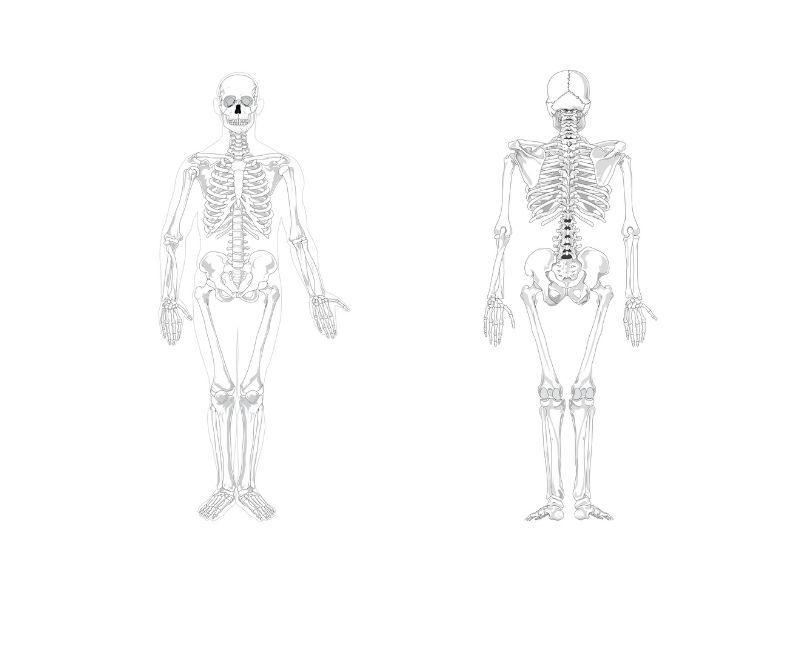Free Printable skeletal system human diagram and video for students and Teachers
Uncover the fascinating world of human anatomy with our comprehensive guide on the skeletal system. Learn about the intricate network of bones, cartilage, and joints that form our body's structural framework. Our resource simplifies understanding of this complex system, making it accessible to students, educators, and enthusiasts alike. From bone structure and joint functionality to disorders affecting the skeletal system, we provide a wealth of information. Start your journey into the captivating realm of the skeletal system with our user-friendly guide. Master the complexities of human anatomy, one bone at a time. Click now to explore more.
skeletal system definition
The skeletal system is defined as the biological system that provides structural support to the body. It is primarily composed of bones, joints, cartilage, tendons, and ligaments. This complex framework not only gives shape and protection to the body, but it also facilitates movement, stores essential minerals, and produces blood cells. The human skeletal system can be divided into two main parts: the axial skeleton, which includes the skull, spine, and rib cage; and the appendicular skeleton, which includes the limbs and the pelvic girdle. In an adult human, the skeletal system typically comprises 206 bones.
skeletal system function
The skeletal system is an essential part of the human body that serves several critical functions:
Support: The skeletal system provides structural support for the body, enabling us to maintain our shape and posture.
Protection: It safeguards our vital organs. For instance, the skull protects the brain, the rib cage shields the heart and lungs, and the vertebrae protect the spinal cord.
Movement: Bones serve as points of attachment for muscles. When muscles contract, they move the bones, facilitating movement.
Mineral Storage: Bones store essential minerals like calcium and phosphorus, releasing them into the body when needed.
Blood Cell Production: The marrow within certain bones produces blood cells in a process called hematopoiesis.
The human skeletal system, an essential biological system, provides structural support and performs many vital functions within the body. Understanding the skeletal system's structure and function is critical for anyone interested in human biology or health sciences. Our comprehensive resources offer an in-depth exploration of the skeletal system, which includes a detailed skeletal system diagram, an exhaustive explanation of the skeletal system function, and clearly labeled illustrations of the skeletal system parts.
Our skeletal system diagram serves as a visual guide to understanding the complexity of the human skeletal system. This diagram, coupled with our detailed explanations of the skeletal system function, gives learners an immersive and comprehensive understanding of how the various components of the system work together to support, protect, and facilitate movement in the body.
We offer resources in multiple languages to cater to a diverse audience. For our Hindi-speaking audience, we provide a detailed explanation of the skeletal system in Hindi, including the skeletal system meaning in Hindi. This ensures a deeper understanding of the skeletal system for those who are more comfortable learning in Hindi.
Alongside these resources, we offer a skeletal system pdf, which serves as an invaluable study guide for learners. This downloadable document provides comprehensive details about the skeletal system, its organs, and its functions. It also includes high-quality skeletal system images to enhance understanding visually.
If you prefer a more interactive learning experience, our skeletal system ppt is an excellent resource. This presentation includes engaging and informative slides that explain the anatomy and function of the skeletal system human body.
The skeletal system's structure is incredibly intricate, involving several types of bones, such as long, short, flat, and irregular bones. We delve into each of these skeletal system types, providing detailed explanations and illustrations.
Our resources also include an easy-to-understand skeletal system drawing. This illustrative tool serves as a useful aid in understanding the skeletal system structure, particularly for visual learners. The skeletal system drawing is accompanied by a skeletal system with label, allowing learners to easily identify and remember the different bones and their locations within the skeletal system.
When it comes to understanding the skeletal system anatomy, our resources shine. We delve into the skeletal system organs, covering everything from the largest bone in the body (the femur) to the smallest (the stapes in the ear). This in-depth look at the skeletal system organs helps learners grasp the complexity and marvel of human biology.
So whether you're a student, an educator, a healthcare professional, or someone with a keen interest in human biology, our resources on the skeletal system are designed to cater to your needs. From the skeletal system function to the skeletal system parts, we cover every aspect in a comprehensive, engaging, and user-friendly manner. Dive into our rich resources today, and explore the wonder of the human skeletal system like never before.






